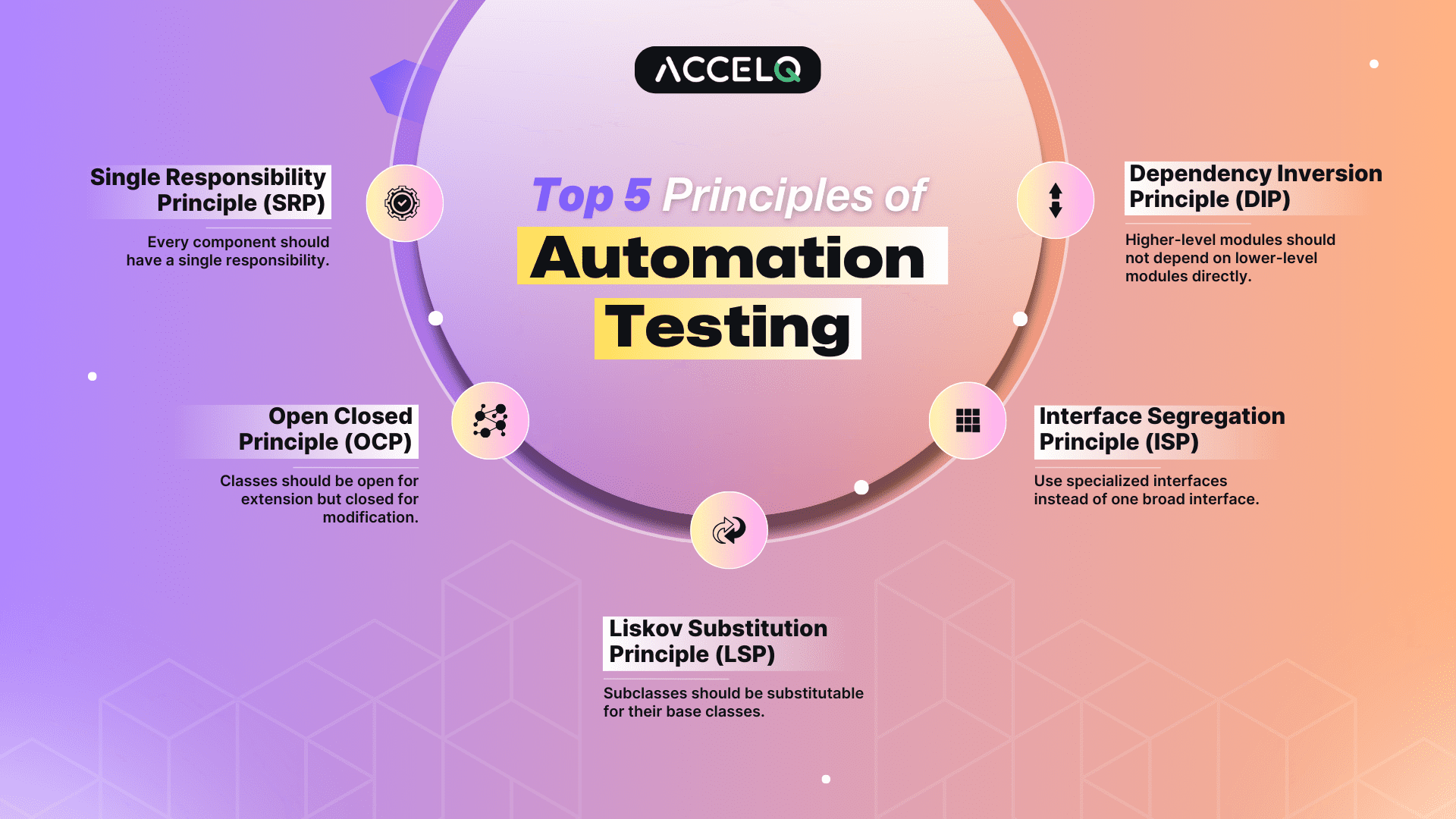Top 5 Principles of Automation Testing

In software development, adaptability and ensuring high-quality output have become indispensable. Test automation boosts software reliability and streamlines development cycles. This shift lets developers focus on creative aspects and move on from manual, repetitive tasks. However, they need to embrace fundamental principles that can shape the design and implementation of automated testing frameworks.
Solid Principles Of Test Automation
SOLID design principles represent a collection of guidelines to minimize dependencies in software design. These principles simplify software design understanding, maintenance, and scalability. It enables the developers to modify one code section without adversely affecting other sections. Every developer must be familiar with and apply these five SOLID principles in today's dynamic business landscape.
1. Single Responsibility Principle (SRP)
Principle:
The Single Responsibility Principle dictates that every class, module, component, or microservice should focus on a single responsibility. This means each should address only one aspect of the software's functionality. Following this principle facilitates easier development, testing, and maintenance. It minimizes the risk of unintended effects from future changes.
Example:
In an e-commerce application's checkout process, features like order summary, shipping address, payment mode, and payment details are involved. Instead of bundling these features into one complex entity, SRP recommends dividing the checkout responsibilities into smaller, focused entities. This ensures that changes in one area do not adversely affect others, maintaining the integrity of the business logic.
2. Open Closed Principle (OCP):
Principle:
The Open Closed Principle is a key concept in software development. Adding new features allows classes, modules, and functions to grow. Importantly, this can happen without altering the existing code. Developers achieve this through the smart use of abstraction. This method keeps the codebase flexible, making it easier to update and maintain.
Example:
An e-commerce platform plans to introduce a new payment method. Following OCP, the development team can add a new "payment" class to accommodate this new method without altering any existing code, seamlessly integrating the new functionality.
3. Liskov Substitution Principle (LSP):
Principle:
The principle named after Barbara Liskov enhances the Open Closed Principle. It ensures that subclasses can take the place of their base classes. This substitution does not alter the application's behavior, boosting the software's reliability and scalability.
Example:
In an e-commerce application, if customers can pay using a credit card or a digital wallet, LSP allows the introduction of a new payment class without causing disruptions. Adding or modifying payment methods doesn't break the application, ensuring smooth operations.
4. Interface Segregation Principle (ISP):
Principle:
The Interface Segregation Principle suggests using several specialized interfaces instead of one broad interface. This approach helps developers by giving them interfaces more closely aligned with their specific needs. Consequently, it makes the system more flexible and easier to understand.
Example:
An e-commerce company uses different interfaces for web clients placing orders and admin clients managing stores and products. ISP suggests keeping these interfaces separate, facilitating the development of new features, and maintaining each interface independently.
5. Dependency Inversion Principle (DIP):
Principle:
Within the "Solid principles in microservices framework," the dependency inversion principle emphasizes separating software modules. It ensures that higher-level modules do not rely directly on lower-level ones. This approach enhances code flexibility and reusability, crucial for creating scalable and loosely coupled microservices. DIP facilitates independent service evolution, embodying the SOLID principles' goals for robust and adaptable software architecture.
Example:
An e-commerce company can use DIP to introduce an abstraction layer around the payment service to switch payment gateways from PayPal to Apple Pay. This allows changing payment gateways without significant codebase modifications, demonstrating the principle's effectiveness in maintaining code flexibility.
Benefits of Applying SOLID Principles to Test Automation
Implementing SOLID principles in test automation brings significant advantages. These principles enable developers to sidestep common pitfalls and craft flexible, agile software. They bolster the code's structure, enhancing readability, maintainability, and testability. Specifically in test automation, SOLID principles:
- Minimize code dependencies, leading to better modularity, easier testing, and enhanced maintainability.
- Simplify code comprehension, making it more straightforward to adapt and scale. This agility allows quick responses to changing business and customer needs.
- Elevate design and code quality, safeguarding against disruptions caused by updates or changes.
- Boost test coverage and execution efficiency, streamlining debugging and ensuring more reliable software.
- Lighten the maintenance load, facilitating swift and painless code refactoring.
Incorporating Principles of Automation Framework Design
Adapting principles of automation framework design in your development strategy is crucial for building robust, scalable, and maintainable test automation. These principles guide you in structuring your framework to support efficient testing processes.
Interface-Driven Design
Use interfaces judiciously to define clear roles within your framework, ensuring that components are modular and interchangeable.
Emphasize Modularity
Design your framework with small, focused modules rather than a monolithic structure. This approach increases flexibility and simplifies updates.
Extend Functionality with Ease
Build your framework to incorporate additional functionality through new modules without altering existing code.
Enhance Feature Integration
Introduce new features by adding modules that use established interfaces, avoiding direct modifications to existing components.
Tool Support for Design Integrity
Use tools to monitor your framework's architectural adherence and provide alerts for deviations from best practices.
Conclusion
These principles ensure the creation of robust, maintainable, and scalable software and empower development teams to innovate confidently. Developers can reduce dependencies, enhance code quality, and meet the dynamic demands of businesses and users alike. Incorporating these practices is a step towards building more efficient, adaptable, and high-quality software solutions that stand the test of time.
Geosley Andrades
Director, Product Evangelist at ACCELQ
Geosley is a Test Automation Evangelist and Community builder at ACCELQ. Being passionate about continuous learning, Geosley helps ACCELQ with innovative solutions to transform test automation to be simpler, more reliable, and sustainable for the real world.
Discover More
 What are the Causes of Failure in Test Automation? (And How to Avoid It)
What are the Causes of Failure in Test Automation? (And How to Avoid It)
What are the Causes of Failure in Test Automation? (And How to Avoid It)
 Test Automation in 2023: Essential Dos and Don’ts for Success
Test Automation in 2023: Essential Dos and Don’ts for Success

































